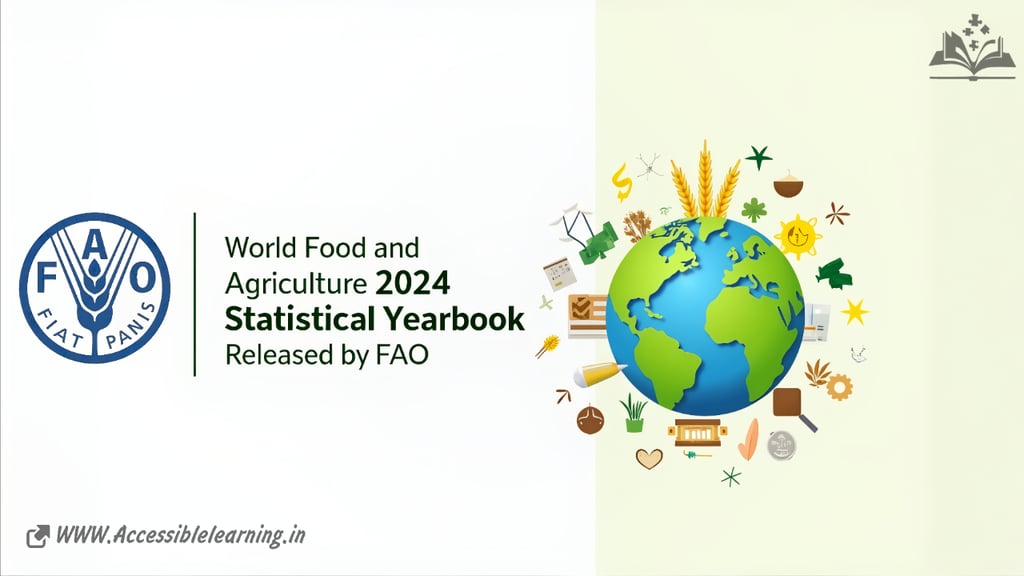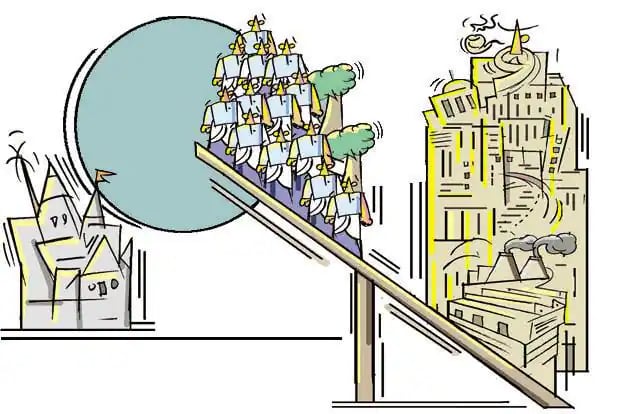
India's Role in Global Agriculture: Insights from FAO's 2024 Yearbook
Explore the key insights from the World Food and Agriculture 2024 Statistical Yearbook released by the FAO. Learn about global agricultural trends, sustainability challenges, food security, production innovations, and trade dynamics shaping the future of the food industry.
HEALTH/DISEASEEDUCATION/KNOWLEDGEINDIA/BHARATGLOBAL ISSUESAWARE/VIGILANT
Sachin K Chaurasiya
1/13/20257 min read


The Food and Agriculture Organization (FAO) of the United Nations has released its World Food and Agriculture 2024 Statistical Yearbook, offering a detailed synthesis of the trends, challenges, and opportunities in the global food and agriculture landscape. This flagship publication is an essential resource for policymakers, researchers, and stakeholders in understanding the complex dynamics shaping the agricultural sector and its impact on the environment, economy, and society.
Economic Dimensions of Agriculture
Agriculture continues to be a significant contributor to global economies, though its role has evolved over the years.
Share in GDP
The contribution of agriculture to global GDP has remained stable at 4% since 2000, reflecting a balance between growth in other economic sectors and sustained agricultural output.
Decline in Agricultural Employment
Despite technological advancements, the sector employed only 26% of the global workforce (892 million people) in 2022, a stark decline from 40% in 2000.
India leads in agricultural workforce: With 226 million people engaged in agriculture, India remains a global leader in agricultural employment. This underscores the sector's importance in rural livelihoods despite urbanization and industrial growth.
Irrigation Infrastructure
India and China lead in irrigation, with 76 million hectares and 75 million hectares, respectively, equipped for irrigation in 2022. This has helped sustain high yields despite fluctuating climatic conditions.
Emerging Economies and Agricultural Development
Countries in sub-Saharan Africa and Southeast Asia are showing potential for growth in agricultural output as investments in mechanization, irrigation, and infrastructure increase.


Production, Trade, and Prices of Commodities
Agriculture remains a globalized sector, with intricate trade networks ensuring food security and economic stability.
Trade Dominance
The Americas and Europe dominate global exports of cereals, contributing significantly to food availability worldwide.
Asia remains the largest importer of cereals, driven by high demand in densely populated nations such as China and India.
India’s Agricultural Leadership
Milk Production: India continues to lead globally in milk production, accounting for 23% of the global share in 2022. This highlights its robust dairy industry supported by smallholder farmers and cooperatives.
Sugarcane and Fisheries: India ranks as the second-largest producer, reflecting its strength in diversified agricultural output.
Food Price Volatility
While global food trade remains robust, price fluctuations due to climate change, geopolitical tensions, and supply chain disruptions pose challenges. The COVID-19 pandemic and ongoing conflicts, such as the Russia-Ukraine war, have further exacerbated these issues.
Food Security & Nutrition
Hunger Statistics
In 2023, 9.1% of the global population (733 million people) experienced hunger, marking a slight improvement from previous years but highlighting persistent inequalities in food access.
Gender Disparities
Food insecurity disproportionately affects women across all continents, exacerbating existing gender inequalities. Women in low-income regions are particularly vulnerable due to cultural norms, limited access to resources, and systemic barriers.
Child Malnutrition
Millions of children under five years suffer from stunting and wasting due to inadequate nutrition. Investments in early childhood nutrition programs are essential to break the cycle of poverty and malnutrition.
Urban vs. Rural Divide
Urban areas face unique challenges in ensuring food security, including higher reliance on imported food and vulnerability to price volatility.


Sustainability and Environmental Aspects of Agriculture
Agriculture is both a driver of environmental change and a sector vulnerable to its impacts.
Declining Agricultural and Forest Lands
Between 2000 and 2022, 91 million hectares of agricultural land and 109 million hectares of forest area were lost. These declines are attributed to urbanization, deforestation, and conversion of land for industrial use.
Regions like sub-Saharan Africa and Southeast Asia have witnessed significant deforestation to meet the rising demand for agricultural commodities.
Greenhouse Gas Emissions
Agriculture accounts for approximately 19-20% of global greenhouse gas emissions, primarily from livestock, rice cultivation, and deforestation.
Methane Emissions: Livestock and paddy fields are significant contributors to methane, a potent greenhouse gas.
Sustainable Practices: The adoption of regenerative agriculture, agroforestry, and carbon-smart farming is being encouraged to mitigate emissions.
Water Use in Agriculture
Irrigation accounts for approximately 70% of global freshwater withdrawals, raising concerns about water scarcity. Countries are increasingly investing in efficient irrigation technologies like drip and sprinkler systems to address these issues.
Innovations in Agriculture
The Yearbook also highlights the critical role of technological advancements in reshaping the agricultural landscape.
Precision Agriculture
Technologies such as drones, IoT sensors, and AI-driven analytics are helping farmers optimize resource use, reduce waste, and improve yields.
Biotechnology
Genetically modified (GM) crops are being adopted to enhance resilience against pests, diseases, and climate change, though debates about their safety and ethics persist.
Digital Agriculture
Digital platforms are empowering smallholder farmers with real-time market information, weather forecasts, and financial services, bridging the rural-urban divide.
Climate Change and Resilience
Impact on Crop Yields
Unpredictable weather patterns, prolonged droughts, and extreme events are threatening agricultural productivity. Crops like wheat, rice, and maize are particularly vulnerable.
Global Initiatives
The FAO emphasizes the need for global collaboration to tackle climate-related challenges. Initiatives such as the UN’s Sustainable Development Goals (SDGs) aim to promote sustainable agricultural practices and reduce food insecurity.
India’s Role in the Global Agricultural Landscape!
India's consistent performance across key agricultural metrics positions it as a global leader. Its vast workforce, robust dairy industry, and advances in irrigation infrastructure are critical assets. However, challenges like fragmented landholdings, dependence on monsoons, and environmental degradation must be addressed to sustain its growth trajectory.


Urban Agriculture on the Rise
With urbanization accelerating globally, urban agriculture is emerging as a significant contributor to food systems.
Urban Food Production: Roof gardens, hydroponics, and vertical farms are becoming prominent in cities, reducing dependency on rural supply chains.
Global Examples: Countries like Singapore and the Netherlands have pioneered urban farming technologies to meet local food demands.
Food Loss & Waste: A Growing Concern
Globally, an estimated 14% of food produced is lost between harvest and retail, while 17% is wasted at the consumer level.
Economic Impact: Food loss translates into economic losses of approximately $400 billion annually.
Environmental Consequences: Food waste contributes to nearly 8-10% of global greenhouse gas emissions, as discarded food decomposes in landfills.
Agricultural Mechanization & Automation
Robotics in Agriculture: Autonomous tractors, robotic harvesters, and weeding robots are being used to increase efficiency and reduce labor dependency.
Digital Platforms: Mobile apps and digital platforms are connecting farmers with buyers and suppliers, improving transparency and market access.
Role of Smallholder Farmers
Smallholder farmers account for 80% of global food production, especially in developing countries.
Challenges: Limited access to credit, infrastructure, and market linkages often hampers productivity.
Empowerment through Cooperatives: Farmer cooperatives are playing a vital role in pooling resources and improving bargaining power.
Agri-Innovation Investments
Startups in Agriculture: Startups are introducing solutions like blockchain for supply chain transparency, AI for yield prediction, and bioengineering for climate-resilient crops.
Public-Private Partnerships: Collaborations between governments and private sectors are driving funding for agricultural research and innovation.
Biodiversity in Agriculture
Decline in Agrobiodiversity: The FAO reports a significant reduction in genetic diversity due to the dominance of monocultures.
Preservation Efforts: Seed banks, such as the Svalbard Global Seed Vault, are safeguarding genetic resources for future generations.
Role of Aquaculture in Food Security
Growth in Fish Farming: Aquaculture production has grown by over 50% in the last two decades, driven by demand for sustainable protein sources.
Regional Leaders: Asia leads in aquaculture production, with China, India, and Indonesia being top contributors.
Climate-Resilient Crops and Practices
Drought-Tolerant Crops: Crops like millets, sorghum, and cassava are being promoted in arid regions.
Conservation Agriculture: Techniques such as no-till farming, crop rotation, and cover cropping are being widely adopted to preserve soil health and reduce emissions.
Youth & Women in Agriculture
Engaging Youth in Agriculture: Programs aimed at involving younger generations are leveraging digital tools and offering entrepreneurship opportunities in agribusiness.
Empowering Women Farmers: Women contribute significantly to agriculture but often face unequal access to land, credit, and education. Initiatives to improve gender equity are vital to unlocking agricultural potential.
Agricultural Trade Dynamics Post-COVID-19
Trade Recovery: The global agricultural trade has rebounded from disruptions caused by the COVID-19 pandemic, though vulnerabilities in supply chains remain.
Diversified Export Strategies: Countries are diversifying export destinations to reduce dependency on specific regions, enhancing resilience.
Sustainable Financing in Agriculture
Green Bonds for Agriculture: Several countries have launched green bonds to fund eco-friendly agricultural projects.
Carbon Credits: Farmers adopting regenerative practices can benefit from selling carbon credits, creating a new income stream.


Digital & Data-Driven Agriculture
Remote Sensing and GIS: Satellite imagery and geographic information systems (GIS) are helping monitor crop health and predict yields.
Big Data Analytics: Data-driven insights are enabling better decision-making for pest control, irrigation management, and resource allocation.
Global Collaboration for Food Security
The Zero Hunger Initiative: Aimed at ending hunger by 2030, this initiative focuses on improving agricultural productivity and ensuring equitable food distribution.
Regional Cooperation: Organizations like the African Union and ASEAN are fostering collaborations to address regional food challenges.
Innovations in Livestock Management
Alternative Proteins: Plant-based and lab-grown meats are gaining popularity as sustainable protein alternatives.
Livestock Health: Vaccination and disease monitoring programs are reducing losses from livestock diseases, especially in developing nations.
Ocean-Based Agriculture
Seaweed Benefits: Seaweed farming provides a sustainable source of food, biofuel, and fertilizer while absorbing CO₂ and improving marine biodiversity.
A Call for Action
The World Food and Agriculture 2024 Statistical Yearbook serves as a critical resource for understanding global trends and challenges in agriculture. As the world grapples with the dual challenges of feeding a growing population and addressing environmental concerns, coordinated action is essential.
Policymakers, industry leaders, and civil society must prioritize:
Investing in sustainable agricultural practices.
Enhancing resilience to climate change.
Reducing inequalities in food access.
Empowering smallholder farmers through innovation and technology.
By addressing these pressing issues, the world can move closer to achieving a sustainable and food-secure future for all.
Subscribe To Our Newsletter
All © Copyright reserved by Accessible-Learning Hub
| Terms & Conditions
Knowledge is power. Learn with Us. 📚


